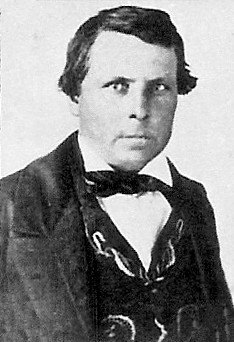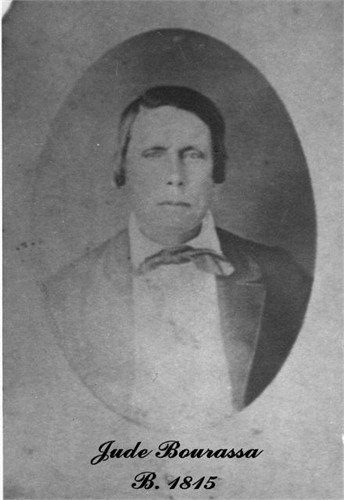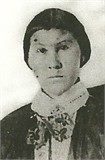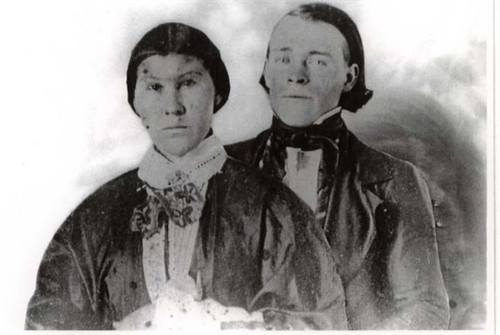We often forget that there were Native American settlers in what we today know as Wabaunsee County, Kansas long before other European immigrants ventured across the Atlantic.
Below are photographs of three individuals who were among the Potawatomi who were removed from their homelands in Michigan and Indiana during the 1830s and 1840s. Although the American government “tidied” it all up by making treaties, paying the tribes a pittance for their land and providing new reservations in the Midwest, these people had no choice. Had they not agreed to all of the stipulations of the American government, they would have been forced off the land by military invasion of their homeland.
The Potawatomi were forced to mostly walk from Indiana to their new lands in what became Kansas, between September 4 and November 4, 1838. A total of 859 men, women and children began the journey from northern Indiana. Although the American government hired one of its heros, John Tipton of Indiana, to make certain they were provided for and watched over, Tipton provided little. The Native Americans walked, they were provided inadequate food and shelter, their medical care was laughable and as a result, 69 people, (there are various numbers reported, larger and smaller) mostly the elderly and children, died. The journey is now commonly referred to as “The Trail of Death.”
If you want to learn more about the history of this tragic journey, you may read “The Potawatomi Trail of Death” written after 30 years of research by two good friends, Shirley Willard and Susan Campbell. http://www.potawatomi-tda.org/ptodassn.htm
There is a shorter article here: http://en.wikipedia.org/wiki/Potawatomi_Trail_of_Death
The real reasons for the removal were many, but primarily their lands in Michigan, Wisconsin and Indiana were needed for the settlement of American and European farmers. The Native Americans were not farmers, they were hunters and gatherers. They were considered to be “subhuman” and therefore needed to be controlled and kept on reservations. In addition, the railroads were building towards the West Coast. Most Americans believed that it was ordained by God that they occupy all of the United States from the east coast to the west coast. The railroads hastened that settlement and made Midwestern and mountain lands accessible. To finance the building of the railroads, the American government needed the land of the Indians. The U. S. Congress took the Indian lands and turned their lands into grants to the railroads. The railroads could then sell Indian land to White settlers and keep the money to be used in constructing their railroads.
That is exactly what happened to the Potawatomi, who were settled on a 3,000,000 acre reserve north of Topeka, Kansas. This reserve contained most of what of what became northern Wabaunsee County, including land between the Kansas River and the Mill Creek Valley. A new treaty was negotiated in 1869, which removed all the Potawatomi from what is today Wabaunsee County, Kansas as well as most of the reserve north of Topeka. Their land was reduced from 3,000,000 acres to 30,000 acres, which remains mostly intact today.
Many of the Potawatomi had been educated at Indian Schools operated by various denominations of religious organizations, most prominently Roman Catholic, Methodist and Baptist. There were Mission Schools in Kansas near Kansas City, Topeka and at St. Marys. There were also Mission School in Michigan and Wisconsin. The three individuals pictured below are Joseph Napoleon Bourassa, his brother Jude Bourassa and Jude Bourassa’s wife, Catherine Charet or Sharrai. They were all highly educated and attended several Indian Mission School in various states during the 1820s and 1830s. Joseph and Jude both spoke English and became important translators and officials for the Potawatomi people in Kansas.
Joseph and Jude both established homes at Uniontown, Shawnee County, Kansas. They lived there, traded with settlers heading west on the Oregon Trail, and maintained both trading posts and inns. Uniontown no longer exists, but it was located very near the little village now known as Willard, Kansas. There was a terrible epidemic of small pox in 1849 and 1850 which killed hundreds of Native and White inhabitants. More than 20 were buried in the Uniontown Cemetery, including many of the Bourassa family.
Jude Bourassa and his wife Catherine (Sharrai) Bourassa, survived the epidemic because they had removed from Uniontown and moved three miles west to Mill Creek in what is now Maple Hill Township, Wabaunsee County, Kansas. They removed to become the grain millers for the Potawatomi people. A stone dame and mill were built on Mill Creek on what is now commonly known as the Brethour Ranch. Remnants of the mill are still visible.
The Bourassa Family was of French Canadian and Native American descent. The Bourassa Family were important in the fur trade era in southern Canada, Michigan, Wisconsin and Indiana. They intermarried with Native American women who lived in the villages where they traded.
I have much more to write about the Bourassa Family. They played an important and early role in the development of Maple Hill Township between 1848 and 1878. You will be amazed at the connections between the Bourassas and the families they married with in the early history of Maple Hill.
I am sorry to have to use such a broad brush approach to the articles I will write about the Bourassas. The importance of their family cannot be underemphasized.
L-R: Joseph Napoleon Bourassa, his brother Jude Bourassa, Catherine (Sharrai) Bourasssa, Jude and Catherine (Sharrai) Bourassa.



